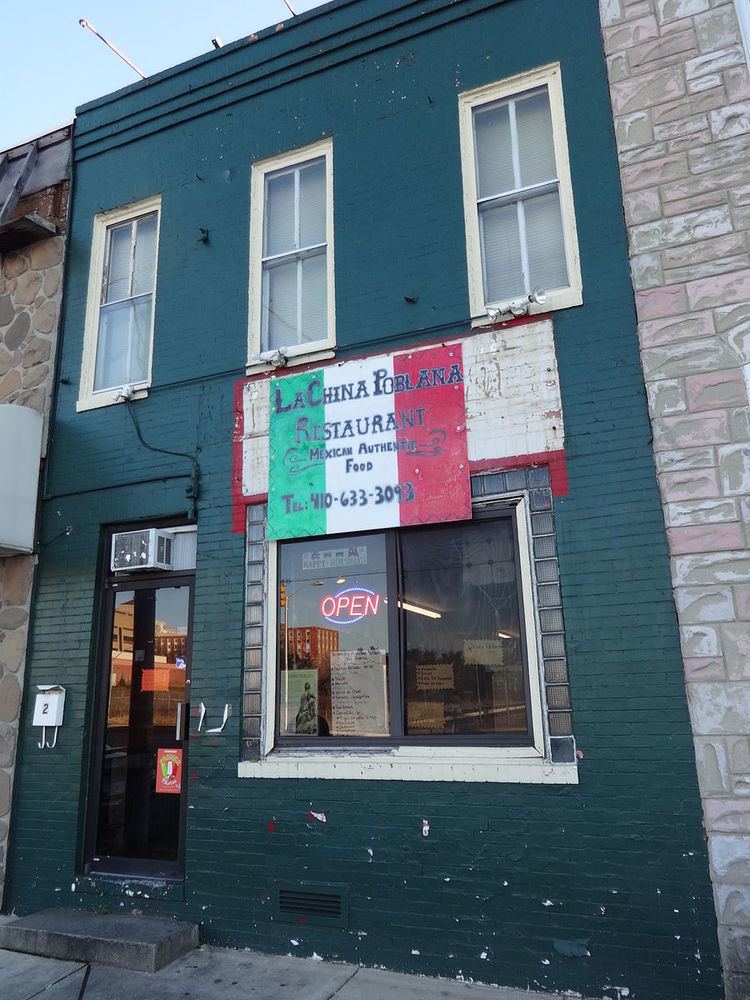 | ||
The history of the Hispanics and Latinos in Baltimore dates back to the mid-20th century. The Hispanic and Latino community of Baltimore is the fastest growing ethnic group in the city. There is a significant Hispanic/Latino presence in many Southeast Baltimore neighborhoods, particularly Highlandtown, Upper Fell's Point, and Greektown. Overall Baltimore has a small but growing Hispanic population, primarily in the Southeast portion of the area from Fells Point to Dundalk.
Contents
Demographics
In 1920, 322 foreign-born White people in Baltimore spoke the Spanish language.
In the 1930 United States Census, there were fewer than 1,000 foreign-born Latinos in Baltimore.
As of the 2000 Census, the Spanish language was spoken at home by 17,805 people in Baltimore. This made Spanish the city's second most spoken language at home. In the same year, 10,193 Latin American-born immigrants lived in Baltimore, comprising 34.4% of all foreign-born residents of the city. This made Latin America the largest region of origin for immigrants.
The 2010 Census found that the Latino population had increased by 9.7% over the past decade. In 2000 Latinos constituted 1.7% of the population and by 2009 Latinos had increased to 3% of the population. As of 2010, Latinos are 4.2% of Baltimore. At 123,029 Latinos as of 2010, Baltimore has the 56th largest Latino metropolitan population in the United States.
As of September 2014, the Spanish language (including Spanish Creole) is the most commonly spoken language in Baltimore after English. Additionally, 19,708 Latin Americans immigrants lived in Baltimore, making Latin America the largest region of origin for immigrants.
Mexican Americans are the largest Latino group in the city. Mexicans make up slightly over a quarter (26%) of Baltimore's Hispanic population, forming a slight plurality over other Hispanics. There are also sizable populations of Puerto Ricans, Salvadorans, Hondurans, Guatemalans, and Dominicans.
History
During the 1920s many Spanish Americans settled in Highlandtown, alongside many Greek Americans.
The first Latino immigrants to the city began arriving in the 1960s. Central Americans and anti-Castro middle-class Cubans were the first to immigrate. They were followed by middle-class immigrants from Argentina, Mexico, Peru, and Puerto Rico.
1980 saw a second wave of immigration from Cuba. Most were oucasts from Cuba, mainly poor and uneducated and many being former prisoners. During the mid-1980s, many Guatemalans and Salvadorans fled to Baltimore in order to escape the Guatemalan and Salvadoran civil wars.
As of 2012, city officials has been encouraging Latinos to immigrate to the city in order to stop or reverse Baltimore's population decline. In order to woo Latinos to the city, Mayor Stephanie Rawlings-Blake had prohibited police and social agencies from asking people about their immigration status. Rawlings-Blake has ordered the creation of a number of outreach programs for Latinos, including city-sponsored classes given in the Spanish language.
Spanish Town
The growing Latino community in Upper Fell's Point is sometimes called Spanish Town. This Spanishtown is found on Broadway Street and is home to a Dominican salon and a Salvadoran supermarket, as well as Guatemalan, Mexican, and Peruvian restaurants
In nearby Greektown, the Latino population is increasing rapidly as the Greek population decreases. Latinos have also settled in Highlandtown.
Baltimore has a relatively small, yet diverse Hispanic population. Most of Baltimore's Hispanic population is in the Southeast section of the city, in areas around Patterson Park and north of Eastern Avenue, especially Highlandtown. Significant Hispanic presence can be seen going in a southeast-ward direction towards Dundalk. Hispanics are starting to act as a medium creating a diverse community wedged between the predominantly black community north of Orleans Street and the predominantly white community south of Eastern Avenue.
Another noticeable pattern is that Central American Hispanics such as Salvadorans, Hondurans, and Guatemalans, majority of which are recent immigrants, are more concentrated in inner Southeast neighborhoods west of Linwood Avenue towards Downtown Baltimore, including Upper Fell's Point and Butchers Hill. Caribbean Hispanics such as Puerto Ricans and Dominicans, some of which come from other states like New York and New Jersey, are mostly concentrated in outer Southeast neighborhoods east of Haven Street towards southeastern Baltimore County, including Greektown and Joseph Lee. Mexicans are the most widespread in Southeast Baltimore. Highlandtown, unlike other Baltimore neighborhoods, is known for its diverse mix of Hispanic groups.
Culture
LatinoFest is a yearly celebration of the cultures of Central and South America held in Patterson Park. The festival includes arts and crafts, dancing, and traditional folk music.
In East Baltimore there exists a chapter of the Brotherhood of the Lord of Miracles. The organization holds an annual procession which honors the Lord of Miracles, a painting of Jesus Christ from Lima, Peru. This image is venerated by Peru's Roman Catholics.
While other cities in the Mid-Atlantic and Northeast have thriving Spanish-language media, Baltimore has lagged behind. However, a few media outlets do exist. Latin Opinion/Opinion Latina is a biweekly newspaper written in English and Spanish that has been published since 2004. The newspaper was the first Spanish-language publication in Baltimore. WLZL is the first FM Spanish-language radio station in the city.
Health
Health disparaities exist between the Latino and non-Latino populations. Latinos are twice as likely as non-Latinos to say that they have poor or fair health. They often do not have access to medical care and fewer mothers receive prenatal care. Due to lack of coverage, many Latinos rely on community clinics. The Highlandtown Community Health Center has a bilingual staff and provides preventative care and treatment to the Latino community.
Legal issues
Some Latinos distrust the police. Because of this, some will not turn to the police to report crimes they have witnessed, including alleged anti-Latino hate crimes. A common reason for not reporting crimes is fear of deportation or deportation of family.
